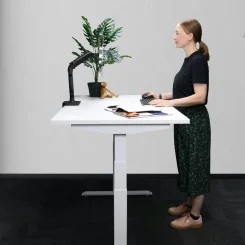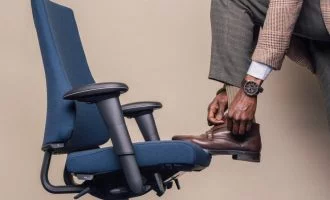What is Osteoarthritis?
Osteoarthritis is the most common type of arthritis in the UK. It is estimated that around 8.75 million people in the UK have seen a doctor about osteoarthritis. Some people call it degenerative joint disease, this is because the cartilage within your joint breaks down. Once the cartilage is worn down, the bones rub together causing friction with each movement. Over time the bone can begin to change shape and small pieces can break off.
Causes
The specific cause for osteoarthritis isn’t known but it is known what could put someone at a higher risk of developing osteoarthritis. This is what the NHS says puts someone at higher risk:
- Age- as you get older, the risk of getting osteoarthritis gets higher.
- If you’ve previously suffered from another type of arthritis- if your joint has been previously damaged by another type of arthritis, you’re at risk.
- A joint injury.
- It runs in the family.
- Being a woman- osteoarthritis affects women more than men.
Symptoms
- Joint pain.
- Stiffness.
- Trouble moving the joint.
- Swelling.
- Tenderness.
- Grating/cracking sounds when moving joints.
How to help osteoarthritis pain
Living and working with osteoarthritis can be painful and difficult. The pain caused by osteoarthritis can make a simple daily activity extremely difficult and uncomfortable. But there are ways you can help to ease and lessen the pain.
If the pain is severe and stopping you from completing simple tasks, talk to your GP, there are medications you can take to help.
The Arthritis Foundation has made a list of supplements that could help Osteoarthritis, they recommend speaking to a doctor before taking any supplements as some can have side effects.
Exercising can be uncomfortable when suffering from osteoarthritis but it could help to strengthen muscles tissue around the joints. A physical therapist can show you the best exercises for this without causing any additional injury.
Working with osteoarthritis
“Back pain, arthritis and other conditions of musculoskeletal pain are some of the main causes of work disability in the UK, accounting for the loss of 10 million working days per year at a cost of £7 billion”- Versus Arthritis
The idea of working with osteoarthritis might seem impossible, if continuing to work is too much there are options and ways you can get support. If you work in a job that is physically demanding you must take extra care when doing physical tasks so you don’t damage yourself further. If you work an office job, there are products you can use to help minimise pain.
When working in an office, a large portion of your day is spent sitting, for people who suffer from hip conditions such as osteoarthritis in the hips, it can be incredibly uncomfortable. One way to help is to consider how you’re sitting and look at your hip angle. When sitting correctly, you should be sitting at an angle slightly above 90 degrees. If you are hips are bent more or less than this angle, it will cause aggravation and discomfort, especially if held in that position for a long period.
To keep your hips at a healthy and comfortable angle, a sitting wedge should be used.
Sitting Wedges
Siting wedges are perfect for people who suffer from hip problems and are suitable for anyone who spends a lot of time sitting. When using a sitting wedge, your pelvis is tilted forward, encouraging an upright posture and enhancing the inward curve of the lower back. Proper spine alignment takes the pressure off joints and muscles, giving your hips a break.
We would recommend a memory foam sitting wedge as it’s extra soft but with a lot of support, memory foam moulds around the body give the best comfort and support.
A back friend is a great product, not only does it have a comfortable cushion, but it also has back support.
-
 Memory foam sitting wedge£65.94 (incl VAT)
Memory foam sitting wedge£65.94 (incl VAT) -
 BackfriendAvailable from:
BackfriendAvailable from:
£81.00 (ex. VAT)
DSE Assessments
If you’re working in an office and suffering from osteoarthritis, the first thing you’ll want to do is take a DSE assessment (Display Screen Assessment). A DSE assessment will help find any flaws and potentially harmful risks with your workstation set up, try out our 99p DSE assessment. You want to make sure you’re sitting correctly so you don’t put any strain on your hips. To find out more about DSE assessments, read through this blog post.
-
 Online Workstation Self-Assessment£1.19 (incl VAT)
Online Workstation Self-Assessment£1.19 (incl VAT)
An ergonomic chair
An ergonomic office chair will help massively with reducing osteoarthritis pain. If you spend a long time sitting down, a comfortable chair with good support is needed. Sitting down too long can make arthritis worse as joints stiffen when they aren’t moved. Walking around in short bursts frequently throughout your day can also help with this problem.
We sell some great ergonomic office chairs that offer good support for the hips, here’s what Ashlea Branch-Parker (one of our expert DSE assessors) recommends.
The Axia Series
The Axia series is great because there’s a chair for everyone. The reason these chairs are suitable for people suffering from Osteoarthritis in the hips is that it allows a lot of movement in the hips. Sitting for long periods will cause the joints to stiffen, this can cause a lot of pain when the user stands up. When you sit on an Axia, the backrest will move with your body. You can change how much that chair moves when you lean by adjusting the tension on the backrest.
-
 Axia 2.2 High Back Office Chair£1,100.40 (incl VAT)
Axia 2.2 High Back Office Chair£1,100.40 (incl VAT) -
 Axia 2.1£991.20 (incl VAT)
Axia 2.1£991.20 (incl VAT) -
 Axia 2.5£1,318.80 (incl VAT)
Axia 2.5£1,318.80 (incl VAT) -
 Axia 2.4£1,263.60 (incl VAT)
Axia 2.4£1,263.60 (incl VAT) -
 Axia 2.3 High Back Office Chair£1,208.40 (incl VAT)
Axia 2.3 High Back Office Chair£1,208.40 (incl VAT)
Standing desk
To avoid stiffening up, try and change position often. A fantastic way to do this is by using a standing desk. A standing desk allows the user to get up and change position whilst still carrying on with work. Not only is it great for your body and could help relieve hip pain, but it helps with back pain too. It could even boost your productivity and wake you up when you’re starting to feel a bit drowsy. For information on standing desks, check out this blog post.
There are two types of standing desks you can get: Adjustable or a sit to stand desk converter.
An adjustable desk can be moved up to a standing height or down to a standard sitting height. It gives you the luxury of switching between working standing up and sitting down, and all you have to do is press a button! We would recommend the HQ standing desk.
-
 HQ Electric Sit Stand Desk£646.80 (incl VAT)
HQ Electric Sit Stand Desk£646.80 (incl VAT)
A sit to stand desk converter is a cheaper option but still just useful if you’re wanting to reduce osteoarthritis pain. A sit to stand desk converter is not a desk but a device you place on top of your desk. It’s a platform to place your keyboard, mouse, and monitor screen/laptop on top of, and that platform can be raised and lowered to suit your height. A portable and simple to use sit to stand desk converter is the Eiger Pro.
-
 Wooden Standing Desk – Eiger Pro£284.40 (incl VAT)
Wooden Standing Desk – Eiger Pro£284.40 (incl VAT)
If you’d like some advice on your workstation and setting it up correctly for users who suffer from Osteoarthritis, please contact us! Call us on 0330 332 0880 or leave us an email at enquiries@posturepeople.co.uk.














